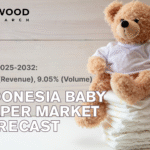SOUTH KOREA INDUSTRIAL ROBOTICS MARKET FORECAST 2024-2032
SCOPE OF THE REPORT
South Korea Industrial Robotics Market by Robot Type (Articulated Robots, Cartesian Robots, SCARA Robots, Cylindrical Robots, Other Robot Types) Market by Application (Material Handling, Assembling & Disassembling, Welding & Soldering, Dispensing, Processing, Other Applications) Market by End-user (Automotive, Electronic & Electric, Machinery Products & Metal, (Chemical, Plastics, and Rubber), Food & Beverage, Other End-users)
REPORTS » AUTOMATION » ROBOTICS » SOUTH KOREA INDUSTRIAL ROBOTICS MARKET FORECAST 2024-2032
MARKET OVERVIEW
The South Korea industrial robotics market is estimated to project a CAGR of 13.06% during the forecast period, 2024-2032, and is set to reach a revenue of $xx million by 2032.
As per the International Federation of Robotics, South Korea boasts 868 robots per 10,000 employees, solidifying its position as a global leader in LCD and memory chip manufacturing, featuring prominent companies like Samsung and LG. Additionally, it serves as a crucial manufacturing hub for motor vehicles and the production of batteries for electric vehicles.
The surge in industrial robots within South Korea is predominantly attributed to the electronics and automotive sectors. Leading companies such as Hyundai, LG Electronics, Samsung, and Yujin Robot have significantly expanded their utilization of industrial robots within their manufacturing facilities. Despite these advancements, South Korea faces distinctive challenges for those involved in robotics, including ongoing tensions with North Korea, which is actively pursuing its own research and development in robotics.

To Know More About This Report, Request a Free Sample Copy
Moreover, the nation is impacted by the US-China trade dispute, as China stands as a significant buyer of South Korean robotics. Despite these challenges, South Korea remains at the forefront of the global robotics landscape, showcasing impressive growth and technological advancements in various sectors.
The South Korea industrial robotics market segmentation includes robot type, end-user, and application. The robot type segment includes cartesian robots, SCARA robots, cylindrical robots, articulated robots, and other robot types (delta and polar robots).
The acronym SCARA stands for Selective Compliance Assembly Robot Arm or Selective Compliance Articulated Robot Arm. SCARA robots exhibit a higher speed compared to similar Cartesian robot systems, owing to their design and functionality. Their single pedestal mount not only demands a minimal footprint but also facilitates easy and unobstructed mounting.
Additionally, their controlling software requires inverse kinematics for linear interpolated moves. Despite this, the controlling software is typically included with the SCARA robot and remains transparent to the end-user.
These robots find extensive application in assembly processes and are characterized by a primarily cylindrical design. Common uses include assembly tasks, pick-and-place operations, and precise glue dispensing. Key players in the SCARA robot market include renowned companies such as Fanuc Corporation and Seiko Epson Corporation.
The deployment of robots, including SCARAs, is becoming increasingly prevalent in manufacturing environments to enhance efficiency, precision, and speed. The industrial robotics market encompasses a wide range of robotic systems designed for tasks such as material handling, welding, packaging, and quality control.
An articulated robot is characterized by its rotary joints, ranging from simple two-jointed structures to complex systems with 10 or more interacting joints and materials. These robots are powered by various means, including electric motors. Some robots, like robotic arms, may be articulated or non-articulated. Articulated robots, also known as 6-axis robots, are particularly advantageous for aligning with multiple planes. They are easy to operate and maintain and can be readily redeployed for plastic injection molding automation across different types and sizes of machines.
These versatile robots find applications in various upstream and downstream processes, offering efficiency in tasks such as welding, painting, material handling, cutting, deburring, and more. Notable companies providing articulated robots include ABB, Ltd., Fanuc Corporation, Epson Robots, Staubli Robotics, KUKA Robotics, and others.
Some of the key players operating in the South Korea industrial robotics market include Nachi Fujikoshi Corporation, ABB Ltd, Yamaha Robotics, etc.
Nachi-Fujikoshi Corp., commonly known as Nachi-Fujikoshi, is a leading manufacturer specializing in the production of cutting tools, machine tools, precision machinery, robots, bearings, hydraulic equipment, special steels, industrial furnaces, and coating equipment. The company, with its headquarters located in Toyama, Japan, operates globally, spanning regions such as Japan, the Americas, Europe, Asia, and Oceania.
REPORT SYNOPSIS
| REPORT SCOPE | DETAILS |
|---|---|
| Market Forecast Years | 2024-2032 |
| Base Year | 2023 |
| Market Historical Years | 2018-2022 |
| Forecast Units | Revenue ($ Million) |
| Segments Analyzed | Robot Type, End-User, and Application |
| Countries Analyzed | South Korea |
| Companies Analyzed | FANUC Corporation, Kawasaki Heavy Industries Ltd, Mitsubishi Electric Corporation, Nachi Fujikoshi Corporation, ABB Ltd, Yamaha Robotics |
TABLE OF CONTENTS
RESEARCH SCOPE & METHODOLOGY
- STUDY OBJECTIVES
- METHODOLOGY
- ASSUMPTIONS & LIMITATIONS
EXECUTIVE SUMMARY
- MARKET SIZE & ESTIMATES
- COUNTRY SNAPSHOT
- COUNTRY ANALYSIS
- SCOPE OF STUDY
- CRISIS SCENARIO ANALYSIS
- MAJOR MARKET FINDINGS
- GROWING UTILIZATION OF ARTIFICIAL INTELLIGENCE TO IMPROVE ROBOTIC APPLICATIONS
- SURGING IMPLEMENTATION OF HUMAN-ROBOT INTERACTION (HRI) FOR SMARTER USE
MARKET DYNAMICS
- KEY DRIVERS
- EMERGENCE OF SMART FACTORIES
- GROWING ADOPTION OF INDUSTRIAL ROBOTS IN FOOD & BEVERAGE, AUTOMOTIVE, ELECTRICAL, AND ELECTRONICS INDUSTRIES
- CONTINUAL R&D AND INVESTMENTS IN ROBOTICS
- KEY RESTRAINTS
- COST OF INITIAL PURCHASE AND MAINTENANCE OF ROBOTICS
- RESISTANCE FROM WORKER UNIONS
- LACK OF SKILLED WORKFORCE
- KEY DRIVERS
KEY ANALYTICS
- KEY TECHNOLOGY TRENDS
- INTEGRATION OF IOT AND AI WITH INDUSTRIAL ROBOTS
- USE OF AUTONOMOUS MOBILE ROBOTS (AMRs)
- SHIFTING FOCUS TOWARD COLLABORATIVE ROBOTS (COBOTS)
- PESTLE ANALYSIS
- POLITICAL
- ECONOMICAL
- SOCIAL
- TECHNOLOGICAL
- LEGAL
- ENVIRONMENTAL
- PORTER’S FIVE FORCES ANALYSIS
- BUYERS POWER
- SUPPLIERS POWER
- SUBSTITUTION
- NEW ENTRANTS
- INDUSTRY RIVALRY
- MARKET CONCENTRATION ANALYSIS
- KEY BUYING CRITERIA
- TASK AND APPLICATION
- EASE OF USE AND PROGRAMMING
- COST AND ROI
- KEY TECHNOLOGY TRENDS
MARKET BY ROBOT TYPE
- ARTICULATED ROBOTS
- MARKET FORECAST FIGURE
- SEGMENT ANALYSIS
- CARTESIAN ROBOTS
- MARKET FORECAST FIGURE
- SEGMENT ANALYSIS
- SCARA ROBOTS
- MARKET FORECAST FIGURE
- SEGMENT ANALYSIS
- CYLINDRICAL ROBOTS
- MARKET FORECAST FIGURE
- SEGMENT ANALYSIS
- OTHER ROBOT TYPES (DELTA AND POLAR ROBOTS)
- MARKET FORECAST FIGURE
- SEGMENT ANALYSIS
- ARTICULATED ROBOTS
MARKET BY APPLICATION
- MATERIAL HANDLING
- MARKET FORECAST FIGURE
- SEGMENT ANALYSIS
- ASSEMBLING & DISASSEMBLING
- MARKET FORECAST FIGURE
- SEGMENT ANALYSIS
- WELDING & SOLDERING
- MARKET FORECAST FIGURE
- SEGMENT ANALYSIS
- DISPENSING
- MARKET FORECAST FIGURE
- SEGMENT ANALYSIS
- PROCESSING
- MARKET FORECAST FIGURE
- SEGMENT ANALYSIS
- OTHER APPLICATIONS
- MARKET FORECAST FIGURE
- SEGMENT ANALYSIS
- MATERIAL HANDLING
MARKET BY END-USER
- AUTOMOTIVE
- MARKET FORECAST FIGURE
- SEGMENT ANALYSIS
- ELECTRONIC & ELECTRIC
- MARKET FORECAST FIGURE
- SEGMENT ANALYSIS
- MACHINERY PRODUCTS & METALS
- MARKET FORECAST FIGURE
- SEGMENT ANALYSIS
- CHEMICAL, PLASTICS, AND RUBBERS
- MARKET FORECAST FIGURE
- SEGMENT ANALYSIS
- FOOD & BEVERAGE
- MARKET FORECAST FIGURE
- SEGMENT ANALYSIS
- OTHER END-USERS
- MARKET FORECAST FIGURE
- SEGMENT ANALYSIS
- AUTOMOTIVE
COMPETITIVE LANDSCAPE
- KEY STRATEGIC DEVELOPMENTS
- MERGERS & ACQUISITIONS
- PRODUCT LAUNCHES & DEVELOPMENTS
- PARTNERSHIPS & AGREEMENTS
- COMPANY PROFILES
- FANUC CORPORATION
- COMPANY OVERVIEW
- PRODUCTS
- STRENGTHS & CHALLENGES
- KAWASAKI HEAVY INDUSTRIES LTD
- COMPANY OVERVIEW
- PRODUCTS
- STRENGTHS & CHALLENGES
- MITSUBISHI ELECTRIC CORPORATION
- COMPANY OVERVIEW
- PRODUCTS
- STRENGTHS & CHALLENGES
- NACHI FUJIKOSHI CORPORATION
- COMPANY OVERVIEW
- PRODUCTS
- STRENGTHS & CHALLENGES
- ABB LTD
- COMPANY OVERVIEW
- PRODUCTS
- STRENGTHS & CHALLENGES
- YAMAHA ROBOTICS
- COMPANY OVERVIEW
- PRODUCTS
- FANUC CORPORATION
- KEY STRATEGIC DEVELOPMENTS
LIST OF TABLES
TABLE 1: MARKET SNAPSHOT – INDUSTRIAL ROBOTICS
TABLE 2: SOUTH KOREA INDUSTRIAL ROBOTICS MARKET, BY ROBOT TYPE, HISTORICAL YEARS, 2018-2022 (IN $ MILLION)
TABLE 3: SOUTH KOREA INDUSTRIAL ROBOTICS MARKET, BY ROBOT TYPE, FORECAST YEARS, 2024-2032 (IN $ MILLION)
TABLE 4: SOUTH KOREA INDUSTRIAL ROBOTICS MARKET, BY APPLICATION, HISTORICAL YEARS, 2018-2022 (IN $ MILLION)
TABLE 5: SOUTH KOREA INDUSTRIAL ROBOTICS MARKET, BY APPLICATION, FORECAST YEARS, 2024-2032 (IN $ MILLION)
TABLE 6: SOUTH KOREA INDUSTRIAL ROBOTICS MARKET, BY END-USER, HISTORICAL YEARS, 2018-2022 (IN $ MILLION)
TABLE 7: SOUTH KOREA INDUSTRIAL ROBOTICS MARKET, BY END-USER, FORECAST YEARS, 2024-2032 (IN $ MILLION)
TABLE 8: LIST OF MERGERS & ACQUISITIONS
TABLE 9: LIST OF PRODUCT LAUNCHES & DEVELOPMENTS
TABLE 10: LIST OF PARTNERSHIPS & AGREEMENTS
LIST OF FIGURES
FIGURE 1: KEY TECHNOLOGY TRENDS
FIGURE 2: PORTER’S FIVE FORCES ANALYSIS
FIGURE 3: MARKET CONCENTRATION ANALYSIS
FIGURE 4: KEY BUYING CRITERIA
FIGURE 5: SOUTH KOREA INDUSTRIAL ROBOTICS MARKET, GROWTH POTENTIAL, BY ROBOT TYPE, IN 2023
FIGURE 6: SOUTH KOREA INDUSTRIAL ROBOTICS MARKET, BY ARTICULATED ROBOTS, 2024-2032 (IN $ MILLION)
FIGURE 7: SOUTH KOREA INDUSTRIAL ROBOTICS MARKET, BY CARTESIAN ROBOTS, 2024-2032 (IN $ MILLION)
FIGURE 8: SOUTH KOREA INDUSTRIAL ROBOTICS MARKET, BY SCARA ROBOTS, 2024-2032 (IN $ MILLION)
FIGURE 9: SOUTH KOREA INDUSTRIAL ROBOTICS MARKET, BY CYLINDRICAL ROBOTS, 2024-2032 (IN $ MILLION)
FIGURE 10: SOUTH KOREA INDUSTRIAL ROBOTICS MARKET, BY OTHER ROBOT TYPES, 2024-2032 (IN $ MILLION)
FIGURE 11: SOUTH KOREA INDUSTRIAL ROBOTICS MARKET, GROWTH POTENTIAL, BY APPLICATION, IN 2023
FIGURE 12: SOUTH KOREA INDUSTRIAL ROBOTICS MARKET, BY MATERIAL HANDLING, 2024-2032 (IN $ MILLION)
FIGURE 13: SOUTH KOREA INDUSTRIAL ROBOTICS MARKET, BY ASSEMBLING & DISASSEMBLING, 2024-2032 (IN $ MILLION)
FIGURE 14: SOUTH KOREA INDUSTRIAL ROBOTICS MARKET, BY WELDING & SOLDERING, 2024-2032 (IN $ MILLION)
FIGURE 15: SOUTH KOREA INDUSTRIAL ROBOTICS MARKET, BY DISPENSING, 2024-2032 (IN $ MILLION)
FIGURE 16: SOUTH KOREA INDUSTRIAL ROBOTICS MARKET, BY PROCESSING, 2024-2032 (IN $ MILLION)
FIGURE 17: SOUTH KOREA INDUSTRIAL ROBOTICS MARKET, BY OTHER APPLICATIONS, 2024-2032 (IN $ MILLION)
FIGURE 18: SOUTH KOREA INDUSTRIAL ROBOTICS MARKET, GROWTH POTENTIAL, BY END-USER, IN 2023
FIGURE 19: SOUTH KOREA INDUSTRIAL ROBOTICS MARKET, BY AUTOMOTIVE, 2024-2032 (IN $ MILLION)
FIGURE 20: SOUTH KOREA INDUSTRIAL ROBOTICS MARKET, BY ELECTRONIC & ELECTRIC, 2024-2032 (IN $ MILLION)
FIGURE 21: SOUTH KOREA INDUSTRIAL ROBOTICS MARKET, BY MACHINERY PRODUCTS & METALS, 2024-2032 (IN $ MILLION)
FIGURE 22: SOUTH KOREA INDUSTRIAL ROBOTICS MARKET, BY CHEMICAL, PLASTICS, AND RUBBERS, 2024-2032 (IN $ MILLION)
FIGURE 23: SOUTH KOREA INDUSTRIAL ROBOTICS MARKET, BY FOOD & BEVERAGE, 2024-2032 (IN $ MILLION)
FIGURE 24: SOUTH KOREA INDUSTRIAL ROBOTICS MARKET, BY OTHER END-USERS, 2024-2032 (IN $ MILLION)
FAQ’s
RELATED REPORTS
-

POLAND MOBILE IMAGING SERVICES MARKET FORECAST 2025-2032
-

UNITED STATES MOBILE IMAGING SERVICES MARKET FORECAST 2025-2032
-

INDIA MOBILE IMAGING SERVICES MARKET FORECAST 2025-2032
-

VIETNAM BABY DIAPER MARKET FORECAST 2025-2032
-

UNITED STATES BABY DIAPER MARKET FORECAST 2025-2032
-

THAILAND BABY DIAPER MARKET FORECAST 2025-2032
-

TAIWAN BABY DIAPER MARKET FORECAST 2025-2032
-

SOUTH AFRICA BABY DIAPER MARKET FORECAST 2025-2032
-

INDONESIA BABY DIAPER MARKET FORECAST 2025-2032
-

INDIA BABY DIAPER MARKET FORECAST 2025-2032
